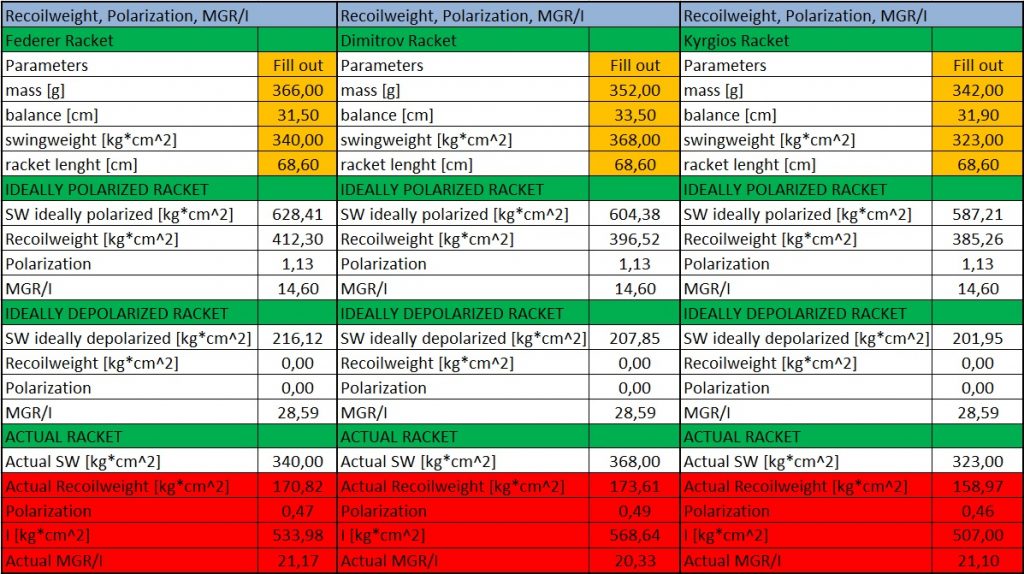
Shop the custom solutios for your tennis gear
MGR/I
I would like to start the introduction to the MGR/I parameter, by comparing the 2 players that often get compared because of how similar their games appear to be.
»I’m talking about Roger Federer and Grigor Dimitrov. It’s true that Grigor is trying to play like Roger, but everything is just so much harder for him and he has to work a lot harder even though he is bigger and stronger. And when they play, Roger can easily overpower Grigor. Why is that? It’s the racket, more precisely the MGR/I value. In short, the MGR/I determines how »easy« is it to time the stroke and ball with a given racket. The Federer and Dimitrov comparison is the perfect example of what customizing for MGR/I can do for your game if you do it right. I should also mention that Dimitrov is reportedly testing and using a racket with a higher MGR/I in the summer of 2018. Supposedly, he is using a variant similar to Roger’s racket. Let’s look at their numbers before Dimitrov switched rackets:
- Roger Federer MGR/I: 21, 17
- Grigor Dimitrov MGR/I: 20, 25
To see how I got this number continue reading below. Now, this might not seem like a big difference, but the MGR/I ranges from around 20 to 21,5 for most rackets. Off course there are also other differences at play, like a bigger head size (93 to 97) a thicker and stiffer beam and a different string pattern (18/17 to 16/19), but I believe that the crucial factor is the bigger MGR/I number, especially when it comes to playing well and trusting the racket in high-pressure situations.«
Someone I should also mention is Nick Kyrgios. His MGR/I is also well above 21, but the mass and swingweight of his racket are much lower than Federer’s. It’s for the lack of swingweight and weight that Kyrgios lacks consistency. But the MGR/I explains why he appears to be so talented. If you type »Kyrgios imitating Federer« in YouTube, you can find some examples of Kyrgios imitating Federer’s service motion perfectly, which makes sense, because MGR/I in a way moulds your service motion. It is kind of hard to explain what different values do, but I’ll try to break it down using MGR/I of 21 to determine a high or low MGR/I. Anything above 21 I consider high and below I consider to be low. The essence of MGR/I can be described as:
The weight, swingweight and balance all play a certain role, but when it comes to swing path, stroke mechanics and timing the ball, MGR/I is the most determinental.
High MGR/I
- Stroke mechanics feel like you are pushing the racket through the contact point instead of pulling it,
- Racket offers better depth control and feel for the ball,
- It is easier to hit the ball early and in front of the body.
- The balls penetrate the court more and don’t have a loopy trajectory, and if the mass is sufficient, the shots still have a lot of spin,
- Players with more »open« forehand grip (like eastern or even continental), can benefit more from a high MGR/I on the forehand side,
- It’s easier to time the ball well, especially in high-pressure situations and when you tighten up.
Low MGR/I
- Stroke mechanics feel like you are pulling the racket through the contact point instead of pushing it,
- Racket offers better feel for curving around the ball instead of hitting through it (think Zverev forehand),
- It is harder to hit the ball early and in front of the body.
- It’s easier to play »safe tennis« with just looping and spinning the ball, but harder to control direction and depth,
- In contrast to high MGR/I – harder to time the ball in high pressure situations and when you tighten up.
Disclaimer: These are not hard scientific facts, but rather findings of an empirical skepticist.
Now let’s take a look at the MGR/I calculations for the players I mentioned before.

Try to keep in mind what I have written about MGR/I and how these players play, and then see if you can wrap your mind around these concepts that I’m trying to explain.
The origin of MGR/I
This is actually not just a parameter that get’s thrown around, but it comes from the physical model of the pendulum. In the chapter swingweight, we have introduced the following equation (1).
\(T_{0}=2\pi \sqrt {\dfrac {I_{p}}{mgR}}\)
(1)
\(\dfrac {T_{0}}{2\pi }=\sqrt {\dfrac {I}{mgR}}\)
(2)
We can replace the period of oscillation with the angular frequency.
\(\omega_{0}=\dfrac {2\pi }{T_{0}}\)
(3)
\(\dfrac {1}{\omega _{0}}=\sqrt {\dfrac {I}{mgR}}\)
(4)
And finnaly we can write down the MGR/I and angular frequency dependancy.
\(\dfrac {mgR}{I}=\omega ^{2}_{0}\)
(5)
The units of the MGR/I are modified so that we get a number around 20 for rackets, and this number as most often used in tennis is just for reference.
You can also calculate MGR/I here:
To get free Racket Customization Tools, including the MGR/I calculator, subscribe here: